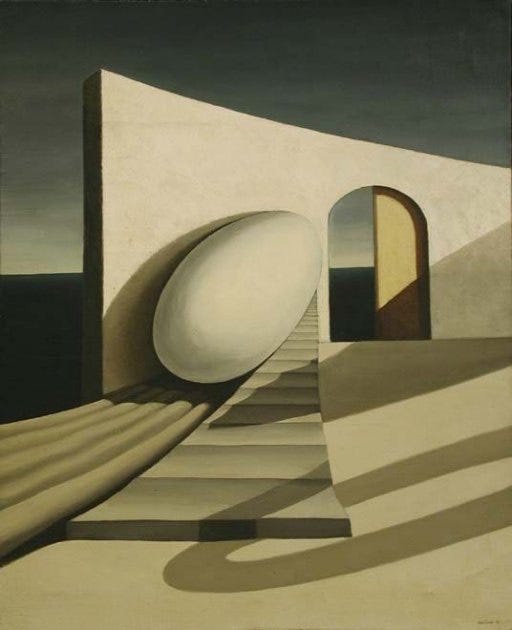Some years ago, back when X was still called Twitter, I did an Easter-themed thread. I say Easter-themed because it was about art eggs, or eggs as depicted in art by Surrealist artists, including Ithell Colquhoun, Leonora Carrington, Leonor Fini, and Kay Sage. As Whitney Chadwick wrote, many women painted eggs because of a correlation between the “alchemical identification of the egg with the woman's creative powers.” At the same time, the “egg also points to the Surrealist preoccupation with symbolizing the process by which an image is generated from interior sources.” Chadwick notes how eggs are “the Pagan emblem of creation and the rejuvenation of spring after the winter sleep, Christian symbol of the Resurrection, alchemical vessel of transfor-mation, the egg has always symbolized creation; it is the source of life and, by extension, the source of all art.”
One of the images I included was Sage’s My Room Has Two Doors (1939), where a large ovoid shape - an egg - appears at the top of a staircase. The egg is the same cool marble hues as its surroundings - pale pink, plaster-like tone and texture - at the top of a sweeping staircase in a room, but leaving what looks like a sand trail (complete with tracks) in its wake. While Sage was never vocal about her alchemical leanings, or how eggs were a symbol of the alchemical feminine, Chadwick continues that Sage’s “childhood fascination with these objects surely influenced her adult habit of keeping china eggs, rocks, and shells in baskets throughout her house,” but, interesting, “there is no evidence that she was interested in pursuing the symbolic significance of the egg.” Chadwick references Stephen Miller, who noted that, “her [Sage’s] attachment to the shape and texture of the egg must have influenced her choice of the title “China Eggs” for her autobiography, a choice reflecting her feeling that china eggs are no more real than was her life before she became a painter. The autobiography terminates with her arrival in Paris and the beginning of her “real" life.”
Giorgio de Chirico significantly influenced Sage during the 1930s, and it would be amiss to say the painting is not de Chirico-esque in terms of the shapes and colour palette. However, it also bears the markings of Sage’s work: structured, deceptively deep despite the sparseness within the frame, and architecturally rich. It’s a dramatic painting, both familiar and fantastical, dreamy and dramatic, opening the doors to our imagination. Yet Chadwick notes that while “Sage’s paintings of 1938 and 1939 reveal that in addition to being strongly influenced by Chirico and Tanguy, she must have also seen Man Ray's photographs of the period around 1936; influenced by Chirico and Tanguy, she must have also seen Man Ray's photographs of the period around 1936; many of the same motifs find their way into paintings like A Little Later (1938).”
“Among them is the recurring image of the egg, the purity of which fascinated Man Ray, and he included it in many of his pictorial and graphic works of the mid 1930s. In 1938, the primary motif in Sage's painting is the egg, an image she shared with many other Surrealists. Sage's father had a collection of rare and unusual birds' eggs, which he kept on white sand in a box.”
The egg of My Room Has Two Doors (1939) is tilted towards an archway, almost pointing towards or reaching for it, attempting to go through the gap to the rich blue sky and sea on the other side of the wall. However, its position is somewhat precarious, almost threatening to roll away. Chadwick observed that Sage used eggs to soften the strict geometry of her compositions, often industrial and bleak, and to heighten the mystery of her works, “implying life and landscapes otherwise devoid of human presence.” As I wrote in a previous newsletter, you only see a human outline in Sage’s work in the 1956 self-portrait Le Passage.
But look closely at the painting, and the arch, and there is another door on the other side, leading somewhere else, if only we could make it there. Dorothea Tanning once said, “My work is about leaving a door open to the imagination so that the viewer sees something else every time.” I feel this also applies to Sage’s work, too.





Very cool.
incredible 🥚